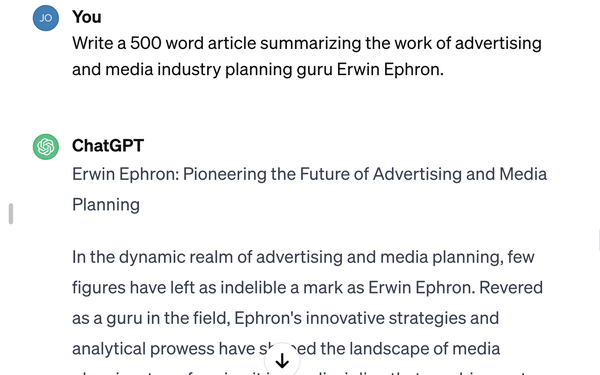
The spirit of media planning guru Erwin
Ephron is still alive and well a decade after his death. And he's even still
publishing new content, thanks to an assist from generative AI platform ChatGPT.
As part of a charitable fundraising initiative, the Advertising Research Foundation (ARF) is publishing a digest of 152 of Ephron's
previously published newsletters, and adding it to its package of "WOW: The Wit and Wisdom of Erwin Ephron" project, which is raising money for the ARF's Charitable Foundation’s Workforce
Initiative for Diversity and Excellence effort.
If you haven't read the newsletters, published between 1993 and 2010, and I recommend you do, the ARF asked ChatGPT to summarize each of them
into a paragraph or two, and then to reinterpret his comments in light of the media environment today.
advertisement
advertisement
What a noble endeavor! But the question I'd really like to ask is one I'd pose to Ephron,
asking him how the proliferation of generative AI content will ultimately impact his core theories on reach, frequency, and recency planning?
In lieu of that, I was inspired by the ARF's
initiative and asked ChatGPT to do the next best thing. Here's my prompt, as well as its response. Hope it's worthwhile.
ChatGPT
Erwin Ephron: Pioneering the Future of Advertising and Media Planning
In the dynamic realm of advertising and media
planning, few figures have left as indelible a mark as Erwin Ephron. Revered as a guru in the field, Ephron's innovative strategies and analytical prowess have shaped the landscape of media planning,
transforming it into a discipline that combines art and science. Let's delve into the key contributions and insights that have made Erwin Ephron a true luminary in the advertising world.
Background and Early Career
Erwin Ephron's journey began in the mid-20th century when he entered the advertising scene. Born in 1931, Ephron witnessed the evolution of media and marketing
through decades of rapid change. His early experiences in the industry paved the way for a career marked by groundbreaking ideas and a relentless pursuit of understanding consumer behavior.
The Recency Planning Model
Ephron's most influential contribution to the field lies in the development of the Recency Planning Model. This model challenged traditional advertising
paradigms, advocating for a shift in focus from frequency to recency. While conventional wisdom suggested that repeated exposure to an advertisement was key to influencing consumer behavior, Ephron's
model posited that the most recent exposure held greater significance.
According to Ephron, the effectiveness of an advertisement is maximized when it reaches consumers close to the point of
purchase. This groundbreaking idea transformed media planning strategies, prompting advertisers to reconsider the timing and context of their messages. Brands began to prioritize reaching their target
audience at crucial decision-making moments, leading to more strategic and impactful campaigns.
360-Degree Consumer View
Ephron's insights extended beyond the traditional realms of
media planning. He emphasized the need for advertisers to adopt a 360-degree view of consumers, considering their entire journey and the multitude of touchpoints that influence their decisions. By
understanding the complex interplay between various media channels, Ephron urged marketers to create cohesive and integrated campaigns that resonated with audiences across platforms.
The
Ephron Analytics Model
At the core of Ephron's approach was a commitment to analytics. He recognized the power of data in unraveling consumer behavior patterns and optimizing advertising
strategies. The Ephron Analytics Model became a guiding framework for marketers, emphasizing the importance of data-driven decision-making in an era increasingly dominated by technology.
Legacy and Continued Influence
Erwin Ephron's impact on the advertising and media planning landscape endures long after his passing in 2013. His ideas laid the groundwork for modern media
planning practices, emphasizing precision, relevance, and adaptability in an ever-evolving industry. Today, media planners and advertisers continue to draw inspiration from Ephron's principles,
integrating data analytics, recency planning, and a holistic consumer perspective into their campaigns.
Challenges and Criticisms
While Ephron's contributions have garnered
widespread acclaim, his ideas have not been without controversy. Some critics argue that the Recency Planning Model oversimplifies the intricacies of consumer behavior and that frequency remains a
crucial factor in certain contexts. Additionally, the shift towards a more data-centric approach has sparked debates about privacy and ethical considerations in advertising.
Conclusion
Erwin Ephron's legacy extends far beyond his years in the advertising industry. His innovative thinking, commitment to analytics, and the development of the Recency Planning Model have left an
indelible imprint on media planning strategies. As the advertising and media landscape continues to evolve, Ephron's principles remain a beacon for those seeking to navigate the complexities of
reaching and influencing consumers in a rapidly changing world. The guru's enduring influence ensures that his contributions will shape the future of advertising and media planning for generations to
come.